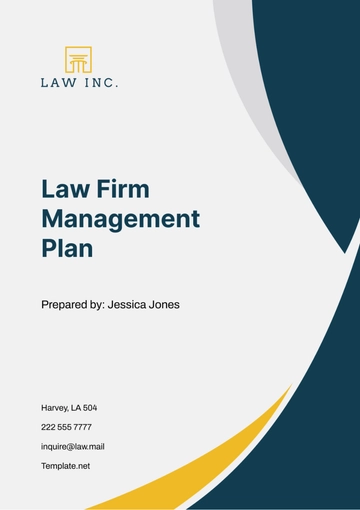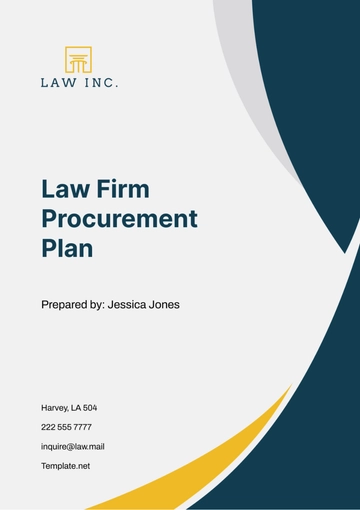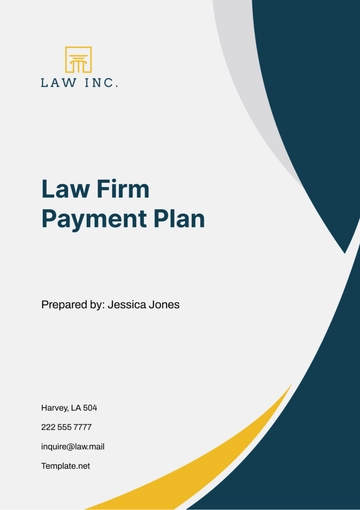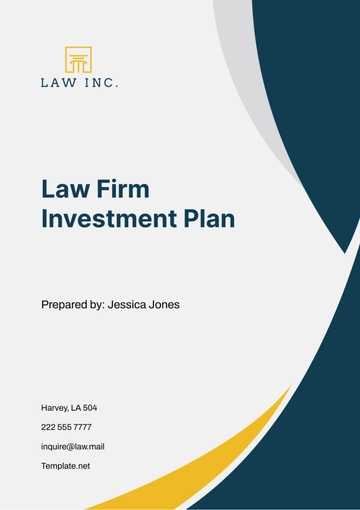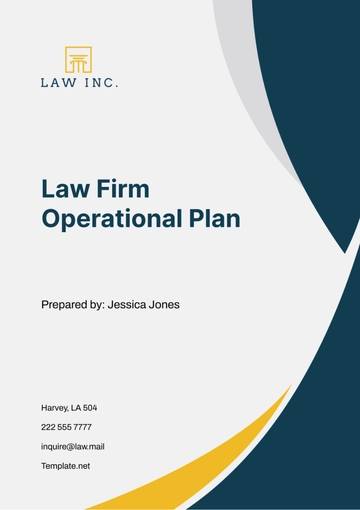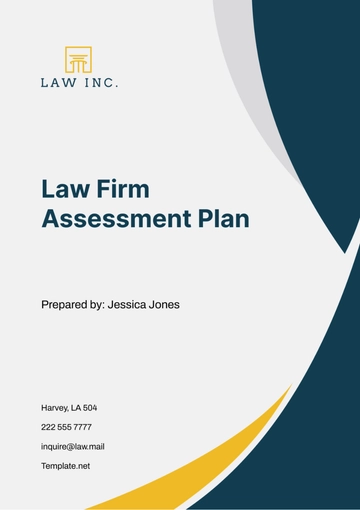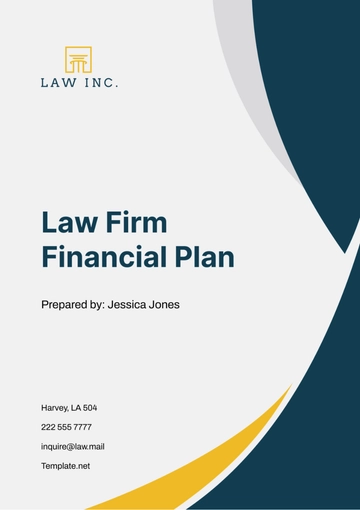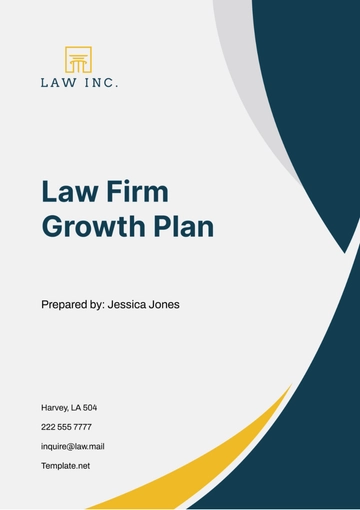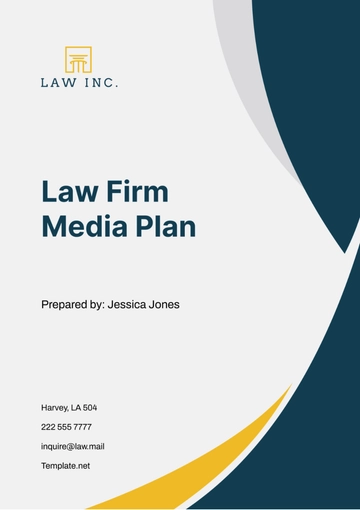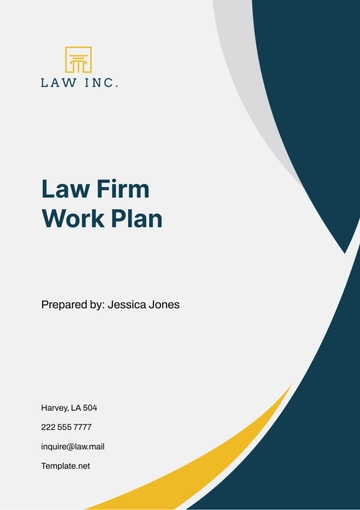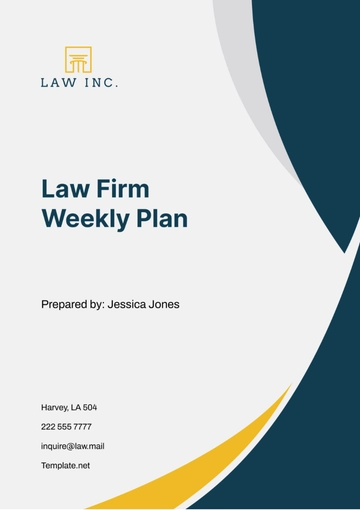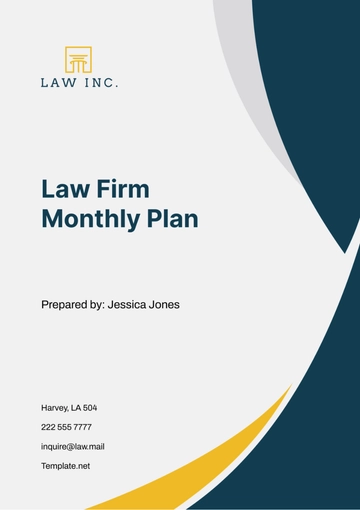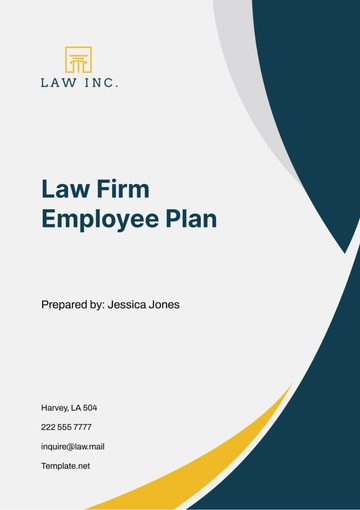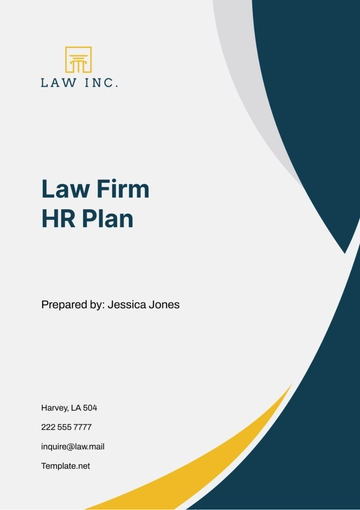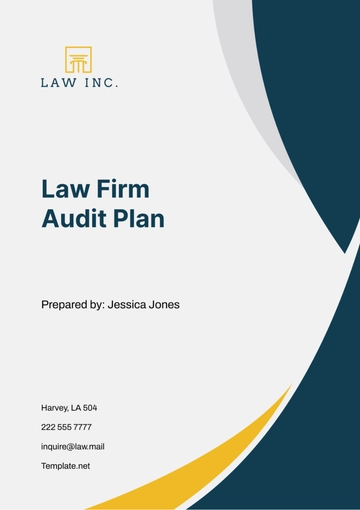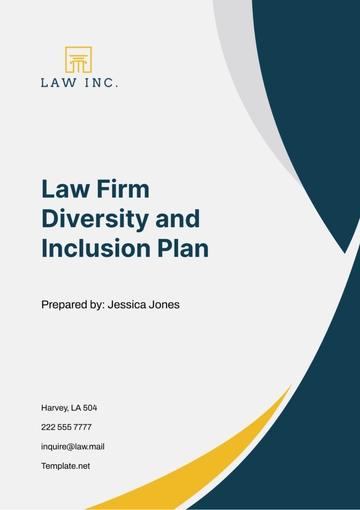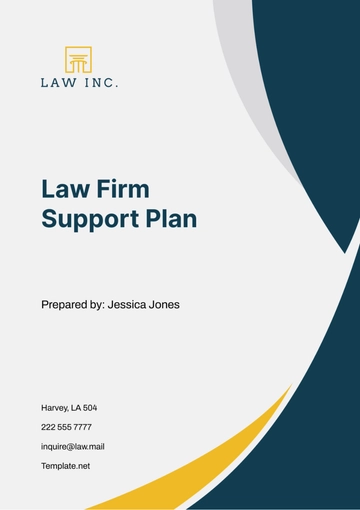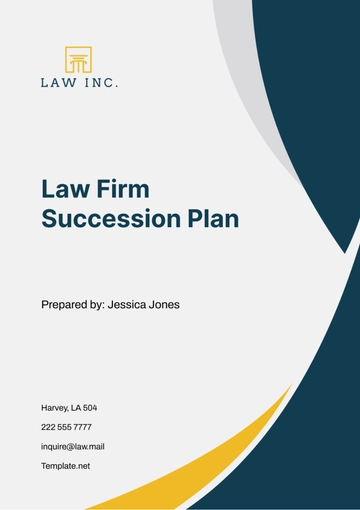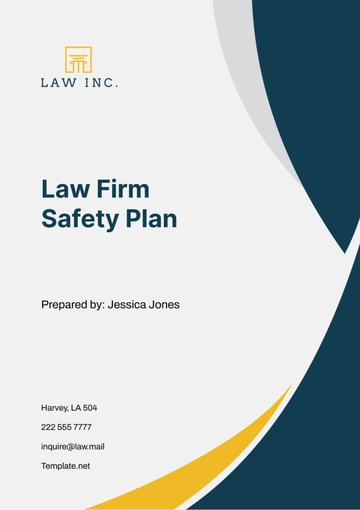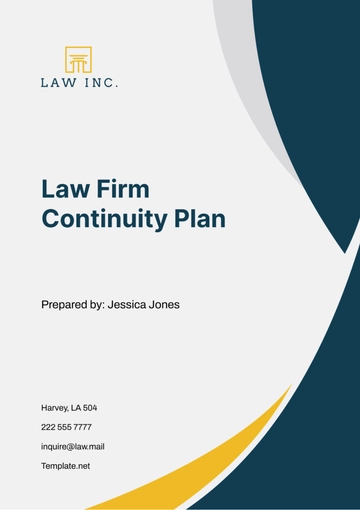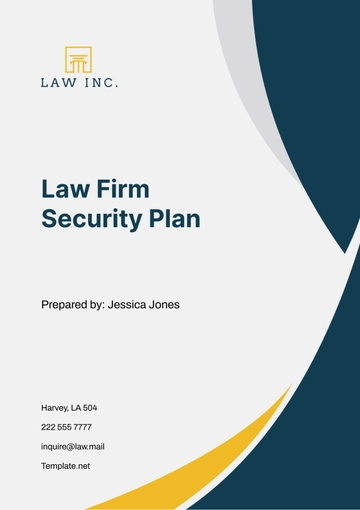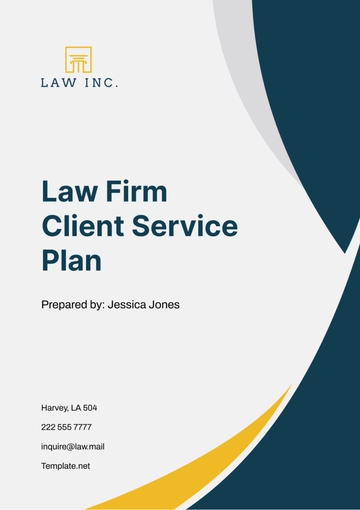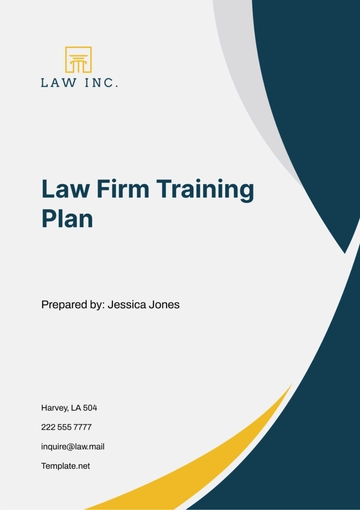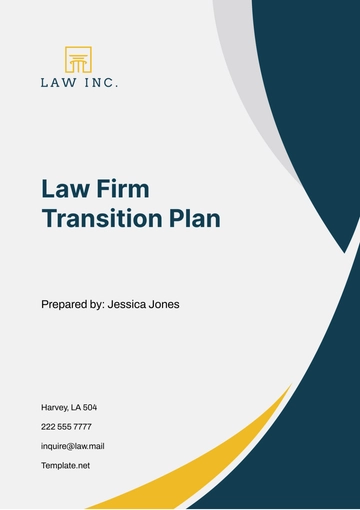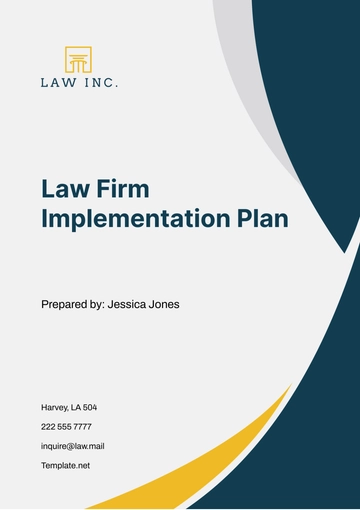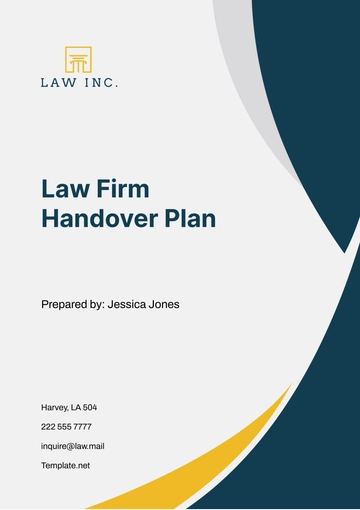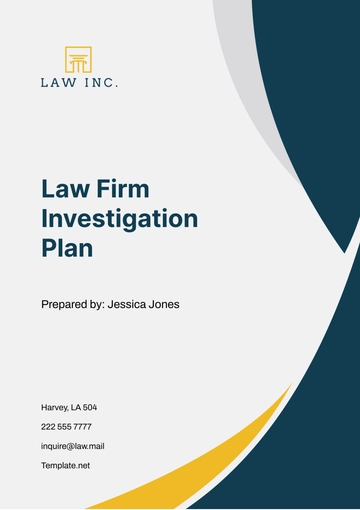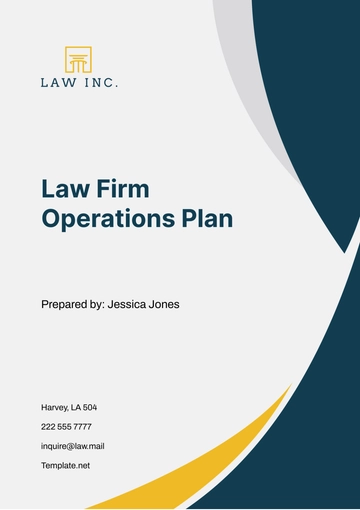Free Law Firm Audit Plan

I. Executive Summary
Our Audit Plan is designed to thoroughly assess the adherence to legal standards, the efficiency of our operations, and the integrity of our financial practices. The objective is to ensure that all areas of our firm are functioning optimally and in compliance with relevant regulations. This systematic review will provide us with essential insights into our practices, identifying areas for improvement and reinforcing our commitment to excellence and compliance.
Key Areas to Be Audited
Financial Transactions and Controls
Client Trust Account Handling
Operational Efficiency and Resource Allocation
Compliance with Legal and Ethical Standards
Information Technology and Data Security
II. Audit Objectives
The primary goal of this audit is to safeguard the integrity of our operations and ensure strict compliance with legal regulations. By conducting this audit, we aim to enhance our internal controls and operational efficiency, thereby improving service delivery and maintaining our reputation as a trustworthy legal service provider.
Verify the accuracy and completeness of financial records.
Assess the compliance of client trust account management with legal standards.
Evaluate the efficiency of internal operations and resource utilization.
Ensure compliance with all applicable legal, ethical, and professional standards.
Examine the security and effectiveness of our IT systems.
III. Scope of the Audit
The scope of this audit encompasses all departments and practices of our firm within the last fiscal year. We will review financial records, client files, internal communication, and IT security logs to ensure comprehensive coverage. The audit will include interviews with staff, examination of process documentation, and evaluation of compliance with policies and procedures.
IV. Audit Criteria
Our audit will be conducted based on a framework of U.S. laws and regulations along with our internal policies. These criteria are chosen to ensure that all aspects of our operations comply with the highest standards of legal and ethical conduct.
American Bar Association (ABA) Model Rules of Professional Conduct
Sarbanes-Oxley Act (SOX) for financial transparency and accountability
Internal Revenue Code provisions applicable to law firms
State-specific regulations governing legal practices
Data Protection laws relevant to client confidentiality and IT security
V. Audit Methodology
To ensure a thorough and effective audit, we will employ a variety of auditing methods tailored to the specific requirements of each audit area. These methods will enable us to collect accurate data and provide reliable insights into the firm’s operations, financial practices, and compliance levels.
Document Review: Systematic examination of financial records, client files, and policy documents.
Interviews: Conducting structured interviews with key personnel to gain insights into processes and controls.
Observations: On-site observation of workflows and practices to assess the practical application of policies.
Data Analysis: Utilizing software tools to analyze transaction patterns and identify discrepancies.
Risk Assessment: Evaluating the potential risks associated with different areas of operation.
VI. Areas of Audit Focus
A. Financial Audits
The financial audit will focus on verifying the accuracy of our accounting records, compliance with accounting standards, and the appropriateness of financial controls. We will review bank reconciliations, analyze ledger entries, and check compliance with tax laws and regulations. Special attention will be given to the handling of client trust accounts to ensure that funds are managed according to legal requirements and ethical standards.
B. Operational Audits
Our operational audit will assess the efficiency and effectiveness of our internal processes. This includes evaluating case management procedures, resource allocation, and operational workflows. The goal is to identify any inefficiencies or bottlenecks that could be streamlined to improve performance and client service delivery.
C. Compliance Audits
The compliance audit will examine our adherence to legal standards, ethical guidelines, and internal policies. This will cover areas such as data protection practices, client confidentiality measures, and adherence to the ABA’s Model Rules of Professional Conduct. We will ensure that all practices are in line with current laws and regulations to mitigate risks of legal penalties and reputational damage.
D. IT Audits
In the IT audit, we will evaluate the security, reliability, and efficiency of our information technology systems. This includes testing cybersecurity measures, data integrity protocols, and disaster recovery plans. The audit will also assess compliance with applicable data protection laws to ensure that client and firm data are securely managed.
VII. Audit Team
The audit team will consist of members with expertise in various fields to ensure a comprehensive evaluation of all areas. Each team member will have specific responsibilities, aligning with their skills and experience.
Role | Responsibilities |
|---|---|
Lead Auditor | Overall coordination of the audit, report finalization |
Financial Auditor | Conduct financial audits, review accounting procedures |
Operational Auditor | Assess operational processes, suggest improvements |
Compliance Auditor | Ensure legal and ethical compliance, review policies |
IT Auditor | Evaluate IT systems, assess security measures |
VIII. Timeline
To ensure a structured and efficient audit process, we have developed a detailed timeline that outlines each step of the audit from initiation to completion. This schedule will help us manage the audit activities effectively and ensure timely delivery of outcomes.
Step | Timeline |
|---|---|
Planning and Preparation | Week 1-2 |
Fieldwork | Week 3-6 |
Data Analysis | Week 7-8 |
Draft Report Preparation | Week 9 |
Review and Finalization | Week 10 |
Presentation to Management | Week 11 |
IX. Reporting
The audit report will be formatted according to the highest standards of clarity and professionalism. It will include an executive summary, detailed findings, recommendations for each area audited, and an appendix containing data and evidence supporting the conclusions. The report will be structured to provide actionable insights and clear guidance on necessary improvements. The standards for the report will follow Generally Accepted Auditing Standards (GAAS) to ensure it meets professional and legal requirements.
X. Follow-Up
Following the audit, it is crucial to address any issues identified in order to improve our operations and compliance. To address issues:
Action Plan Development: Create detailed action plans for each major finding, specifying corrective measures, responsible persons, and timelines for implementation.
Regular Progress Reviews: Schedule monthly meetings to review the progress of action plan implementation.
Re-audit of Problem Areas: Conduct follow-up audits for areas where significant issues were found to ensure that corrective actions have been effectively implemented.
Continuous Improvement Program: Integrate lessons learned into a continuous improvement program to prevent future issues.
XI. Resources Required
Conducting a comprehensive audit requires adequate resources across various dimensions.
Resource Type | Requirements |
|---|---|
Human |
|
Technology |
|
Financial |
|
- 100% Customizable, free editor
- Access 1 Million+ Templates, photo’s & graphics
- Download or share as a template
- Click and replace photos, graphics, text, backgrounds
- Resize, crop, AI write & more
- Access advanced editor
Law Firm Audit Plan Template from Template.net is meticulously designed to ensure thorough compliance and financial scrutiny. This customizable and editable template simplifies the audit process for legal entities, fully editable in our AI Editor tool, providing a strategic framework to maintain integrity and oversight effectively.
You may also like
- Finance Plan
- Construction Plan
- Sales Plan
- Development Plan
- Career Plan
- Budget Plan
- HR Plan
- Education Plan
- Transition Plan
- Work Plan
- Training Plan
- Communication Plan
- Operation Plan
- Health And Safety Plan
- Strategy Plan
- Professional Development Plan
- Advertising Plan
- Risk Management Plan
- Restaurant Plan
- School Plan
- Nursing Home Patient Care Plan
- Nursing Care Plan
- Plan Event
- Startup Plan
- Social Media Plan
- Staffing Plan
- Annual Plan
- Content Plan
- Payment Plan
- Implementation Plan
- Hotel Plan
- Workout Plan
- Accounting Plan
- Campaign Plan
- Essay Plan
- 30 60 90 Day Plan
- Research Plan
- Recruitment Plan
- 90 Day Plan
- Quarterly Plan
- Emergency Plan
- 5 Year Plan
- Gym Plan
- Personal Plan
- IT and Software Plan
- Treatment Plan
- Real Estate Plan
- Law Firm Plan
- Healthcare Plan
- Improvement Plan
- Media Plan
- 5 Year Business Plan
- Learning Plan
- Marketing Campaign Plan
- Travel Agency Plan
- Cleaning Services Plan
- Interior Design Plan
- Performance Plan
- PR Plan
- Birth Plan
- Life Plan
- SEO Plan
- Disaster Recovery Plan
- Continuity Plan
- Launch Plan
- Legal Plan
- Behavior Plan
- Performance Improvement Plan
- Salon Plan
- Security Plan
- Security Management Plan
- Employee Development Plan
- Quality Plan
- Service Improvement Plan
- Growth Plan
- Incident Response Plan
- Basketball Plan
- Emergency Action Plan
- Product Launch Plan
- Spa Plan
- Employee Training Plan
- Data Analysis Plan
- Employee Action Plan
- Territory Plan
- Audit Plan
- Classroom Plan
- Activity Plan
- Parenting Plan
- Care Plan
- Project Execution Plan
- Exercise Plan
- Internship Plan
- Software Development Plan
- Continuous Improvement Plan
- Leave Plan
- 90 Day Sales Plan
- Advertising Agency Plan
- Employee Transition Plan
- Smart Action Plan
- Workplace Safety Plan
- Behavior Change Plan
- Contingency Plan
- Continuity of Operations Plan
- Health Plan
- Quality Control Plan
- Self Plan
- Sports Development Plan
- Change Management Plan
- Ecommerce Plan
- Personal Financial Plan
- Process Improvement Plan
- 30-60-90 Day Sales Plan
- Crisis Management Plan
- Engagement Plan
- Execution Plan
- Pandemic Plan
- Quality Assurance Plan
- Service Continuity Plan
- Agile Project Plan
- Fundraising Plan
- Job Transition Plan
- Asset Maintenance Plan
- Maintenance Plan
- Software Test Plan
- Staff Training and Development Plan
- 3 Year Plan
- Brand Activation Plan
- Release Plan
- Resource Plan
- Risk Mitigation Plan
- Teacher Plan
- 30 60 90 Day Plan for New Manager
- Food Safety Plan
- Food Truck Plan
- Hiring Plan
- Quality Management Plan
- Wellness Plan
- Behavior Intervention Plan
- Bonus Plan
- Investment Plan
- Maternity Leave Plan
- Pandemic Response Plan
- Succession Planning
- Coaching Plan
- Configuration Management Plan
- Remote Work Plan
- Self Care Plan
- Teaching Plan
- 100-Day Plan
- HACCP Plan
- Student Plan
- Sustainability Plan
- 30 60 90 Day Plan for Interview
- Access Plan
- Site Specific Safety Plan

